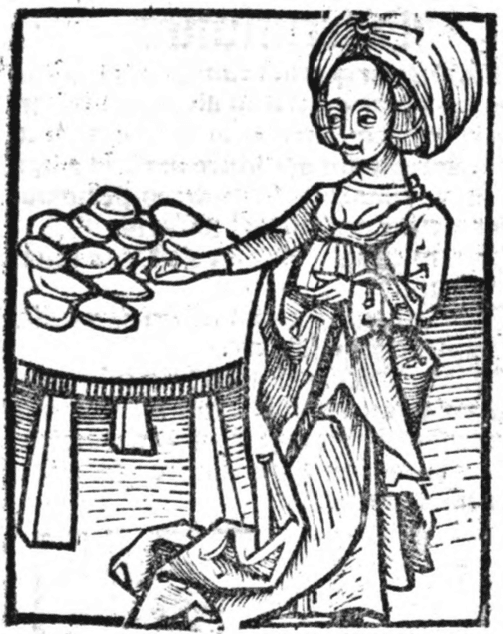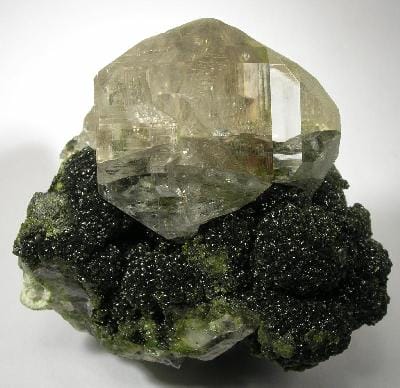Ceruse, White LeadCerussa; Flake Lead; Psimytim, AphidegiOxydum Plumbi, Oxydum Plumbi album, Cerussa alba, Subcarbonas Plumbi, Carbonas Plumbi, Subacetas Plumbi Isfidaj (Unani) |

|
 Ortus Sanitatis, Beck, 1517
Ortus Sanitatis, Beck, 1517 Cerussite crystals on Duftite matrix (from Namibia)
Cerussite crystals on Duftite matrix (from Namibia)Photo by Rob Lavinsky iRocks.com
Mineralogical name:
Ceruse. Basic Lead Carbonate. PbCO3 (Pb 80%; PbO 86.3%; CO2, 11.3%)
It is a complex salt composed of both carbonates and hydroxides of Lead.
Parts Used:
It may be found naturally in the form of Cerussite, but was usually prepared artificially.
Temperature & Taste:
Cold, dry. Toxic
“It is Cold and Dry in the Second degree”. (Avicenna)
Properties:
Crystal system: massive granular, reticulate, tabular
Color: Colorless, white, gray, blue, or green
Streak: White
Cleavage: good
Fracture: brittle
Luster: adamantine, vitreous, resinous
Transparency: Transparent to translucent
Hardness: 3 to 3.5
Specific Gravity: 6.5
Classifications:
T. External Medicines
Uses:
1. Clears Heat, Benefits the Sight:
-the Bhasma is used in Ayurveda for a variety of Eye diseases such as Myopia, Hypermetropia, Cataract, Conjunctivitis, Glaucoma and Corneal opacity.
-strengthens the Eyes, improves their appearance and both treats and prevents diseases of them. (Ayurveda)
-used around the eye-lids (like antimony) to protect and beautify the eyes.
3. Clears Heat, Stops Bleeding:
-heat diseases manifesting with Bleeding from various parts of the body. (Ayurveda)
-Menorrhagia. (Ayurveda)
4. Contraceptive:
-when correctly used, the purified product is said to be able to ‘cause Menopause’, thereby acting as an Oral Contraceptive. (Dash)
-it was also used traditionally to quench Lust.
5. Used in Alchemy:
-In Alchemy, it is said to ‘Kill Gold’, and helps soften certain Metals.
6. Externally:
-especially used topically for all chronic, foul, non-healing and cancerous Ulcers (West)
-Chronic Ulcers including those of the Legs. (Ayurveda)
-“heals the Wounds by promoting the growth of (healthy) flesh and removing the decayed flesh. The Red Lead [Minium] is more potent in this respect” (Avicenna)
-“It softens Cold and Hard swellings” (Avicenna)
-“useful for pimples on inner side of eye lids”. (Avicenna)
-“useful in Anal rupture”. (Avicenna)
Dose:
Generally obsolete. It has been used internally, but was most used externally.
Comment:
1. Although Lead preparations are still used internally in some systems, they have no place internally in Traditional Medicine practiced in the West. Lead preparations could potentially still be used externally, particularly for chronic Ulcers.
2. Lead Sulphide and Antimony were traditionally both confused and used synonymously. Antimony is often applied to the eyes, still today, to protect from various eye diseases. Modern research has found Antimony to be toxic to the Eyes, while Lead Sulphide is not.
Preparation:
“Processed with vinegar becomes highly rarefactive and it quickly reaches the deeper parts of the body”. (Avicenna)
Substitute:
Zinc oxide
Main Combinations:
1. Leg Ulcers:
i. topically with Bile (Galen)
ii. Ceruse, Bile (Swan) and Turpentine applied heal deep sores and ulcers of the legs (The Secrets of Alexis, 1615)
2. Scrofulous Ulcers, Ceruse (1 part), Oak bark (12 parts); powder and sprinkle on. (Pharmacopoeia medici practici universalis, Bruxelles, 1817)
3. Erysipelas: Ceruse, Chalk (1 oz.), Kaolin (2 oz.), Spirit of Camphor (sufficient to make a paste to make into balls). (Pharmacopoeia Generalis, 1783)
4. Burns:
i. Camphorated White Ointment, Ointment of Marshmallow (equal parts). Mix. (Pharmacopea Usuelle, Louvain, 1821)
ii. Camphor (1 oz.), Rose oil (3 oz.), Ceruse (6 oz.), Olibanum (2 oz.), Egg whites (7). Triturate. (Dispensatorium medico pharmaceuticum Palatinatus, 1764)
iii. Elder bark, Lime tree bark, Plantain juice, Houseleek juice, Linseed oil, Suet, Ceruse. (Pharmacopoeia Wirtembergica, 1798)
5. Inflammations and Pain from Heat, Ceruse with Camphor and Vinegar topically
6. Opthalmia:
i. Ceruse (4 oz.), Starch (3 drams), Gum Arabic (1 dram), Tragacanth dissolved in Rose Water (1 ½ oz.). (Memorial Pharmaceutique, 1824)
7. Hemorrhoids:
i. Ceruse, Tragacanth, Starch, Camphor, Egg white, form an ointment with Rose oil, Mullein oil and Yellow Wax. (Dispensatorium medico pharmaceuticum Palatinatus, 1764)
Major Formulas:
Plaster for Leg Ulcers (Galen)
Plaster of Calamine
White Ungent
Ointment of Ceruse Camphorated (Rhasis)
Cautions:
1. Toxic. Should not be used internally.
2. Used externally for 2–3 weeks, then have a break in treatment.
Toxicity:
Lead is toxic and accumulative when taken internally. Allowed levels are very low, measure in parts per million. However, when used topically on Wounds and Ulcers, Lead forms an insoluble compound which protects from infection and promotes healing. Therefore it may still be used in obstinate and chronic Ulcers.
Main Preparations used:
Washed Ceruse, White Ointment, White Troches
1. White Ointment:
Used for Wounds, Ulcers, as well as Strains of the joints.
i. Simple Ointment (5 parts), Ceruse (1 part). Mix. (Edinborough)
ii. Olive oil (3 parts), White Wax, Ceruse (1 part each). Make an ointment. (Memorial Pharmaceutique, 1824)
iii. Olive oil (0.75 oz.), Wax, washed Ceruse (of each 2 oz.). Melt the wax in the oil, mix in the Ceruse;
iv. White Wax (3 parts), Rose oil (12 parts), Ceruse (4 parts). Make an ointment. (Pharmacopoeia Sardoa, 1773)
2. Camphorated White Ointment:
i. White Ointment (24 parts), Camphor, triturated with Oil of Almonds (1 part). Triturate. (Dispensatorium Pharmaceuticum, 1777)
3. White Troches (of Rhazes):
The following are reformed formulas which often still carried the name of Rhazes.
i. Ceruse (5 drams), Tragacanth (3 drams). triturate together. (Pharmacopoeia medici practici universalis, Bruxelles, 1817)
ii. Ceruse (1 ½ oz.), Gum Ammoniac, Starch (2 drams), Camphor (½ dram). Powdered separately, mix and form troches with water.
iii. Ceruse (6 drams), Gum Arabic, Tragacanth (½ oz. each), Sarcocolla (3 oz.). Powder. (Dispensatorium Pharmaceuticum, 1777)
iv. Ceruse (10 drams), Starch (½ oz.), Gum Arabic, Tragacanth (2 drams each), Camphor (½ dram). Powder. (Pharmacopoeia Amstelodamensis, 1792)
-
Extra Info
-
History
|
Salmon, Seplasium: ‘It is prepared by Vaporous Calcination of Lead.’ ‘All sorts of Ceruse and White Lead, are cold, bind, and incrassate; they repress Lust, fill Ulcers with flesh, dry, heal, and cicatrize, are said to be good in Excrescencies, help Cheronious, Phagedenick, Cacocthick, Cancerous, and other malignant Ulcers; they are also good against Tetters, Ringworms, Burnings and Scaldings; They dissolve hard and scirrhus [Fibroid] Tumors, are good against Bruises, as also against Redness and Inflammations of the Eyes, being used with well-water, or applied to the Eye-lids in an Ointment. They are also good against the Piles or Hemorrhoids, Inflammations and Ulcers of the Fundament [anus], mixed with Oil Olive, and anointed; and they heal and cicatrize those Sores and Ulcers, which are otherwise hardly to be cured. Inwardly taken it is mortal, causing a Cough, Dryness, Sluggishness, difficulty of Breathing, Shortness of Breath, and at last Death’. |
How to Make Ceruse From Paracelsus: ‘The preparation of Cerussa for Medicine is as follows: Suspend plates of Lead in an unglazed vessel over strong Vinegar made from wine, the vessel in warm ashes, or, in winter, behind the fire. Then, after ten or 14 days, you will find the very best cerussa adhering to the plates. Scrape this off with a Hare’s foot, and replace the plate over the Vinegar until you have sufficient Cerussa. The other preparation of Cerussa for Alchemy is like the former, save that a quantity of the best Sal Ammoniac must be dissolved in the Vinegar. In this way you will have a very beautiful Cerussa, most suitable for purging Tin or Lead, or for removing whiteness from Copper’. |
